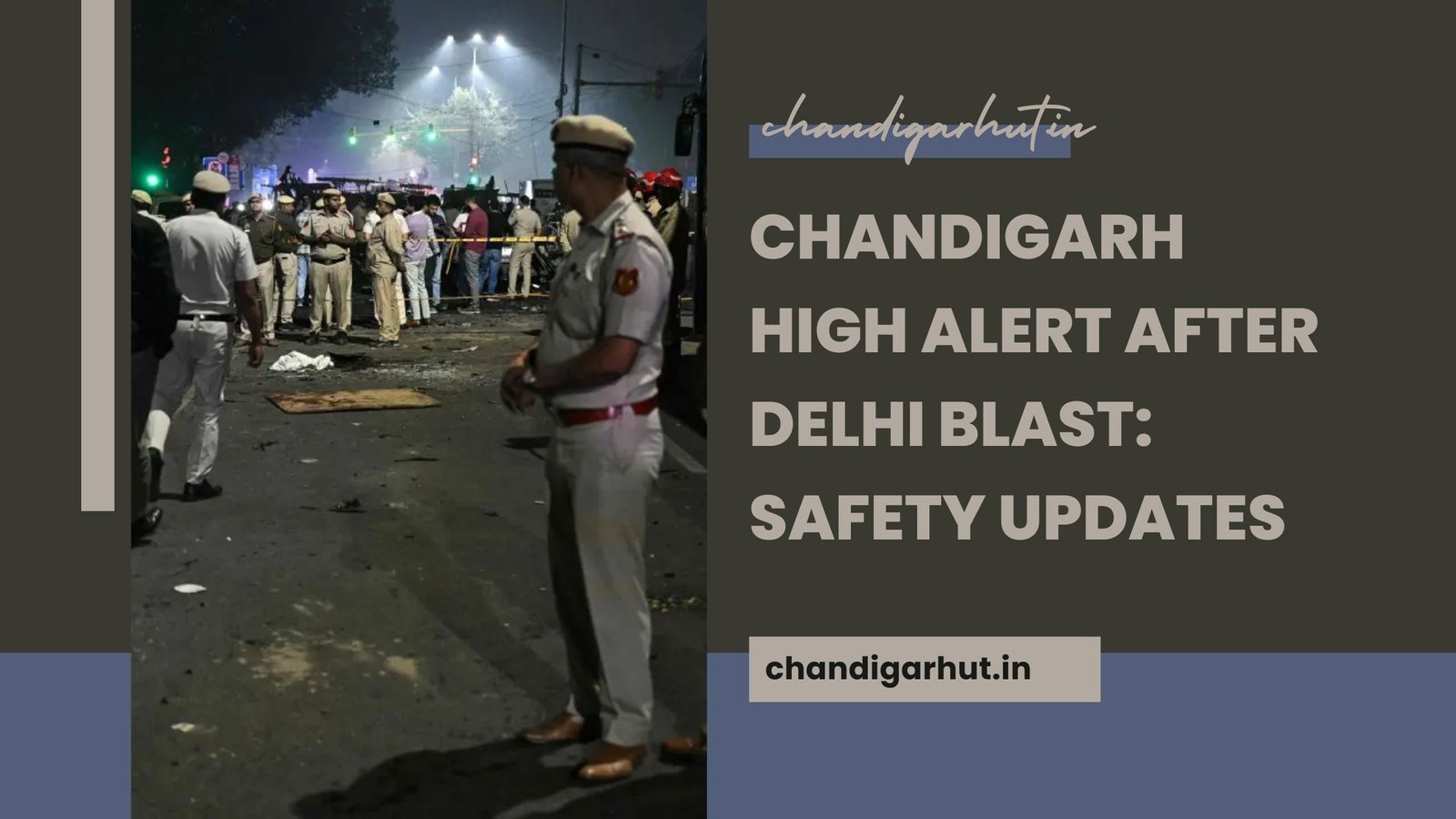The Chandigarh high alert after Delhi blast has sent waves of concern and urgency throughout the city. Following the tragic incident in the national capital, authorities in Chandigarh have swiftly stepped up surveillance, tightened security checks, and enhanced coordination among various agencies. These measures aim to ensure that Chandigarh remains safe, vigilant, and fully prepared for any potential threat.
The Chandigarh high alert after Delhi blast is not merely a reactive measure — it represents a proactive stance to prevent any spillover of danger from Delhi to other northern cities. From increased patrolling to public advisories, Chandigarh Police and administration are taking every step to protect both residents and visitors.
Introduction: Why Chandigarh Is on High Alert
The Chandigarh high alert after Delhi blast was declared immediately after the explosion in Delhi raised security concerns across northern India. Even though no direct link has been found between the two cities, Chandigarh’s strategic importance — as the shared capital of Punjab and Haryana and a major administrative hub — makes it a priority zone for preventive measures.
Authorities have mobilized additional police forces, enhanced surveillance at public locations, and urged citizens to stay cautious. The administration has also increased communication with intelligence agencies to monitor any suspicious movement in and around the Tricity region, including Mohali and Panchkula.
Why this alert matters:
- Chandigarh houses numerous government buildings and high-security establishments.
- Preventive vigilance helps deter potential incidents before they occur.
- Real-time monitoring boosts public confidence in law enforcement.
The Chandigarh high alert after Delhi blast reinforces the city’s commitment to safety and quick crisis management.
Security Measures Implemented Across Chandigarh
In response to the Delhi explosion, multiple preventive actions have been initiated under the Chandigarh high alert after Delhi blast protocol. These layered security strategies are designed to ensure both visibility and readiness.
1. Checkpoints and Roadblocks
Police checkpoints have been established at all major intersections, sector divides, and entry/exit points such as Chandigarh–Ambala Highway, Zirakpur, and Sector 26. Random vehicle checks and identity verifications are being conducted to detect any suspicious items or individuals.
2. Enhanced Surveillance
CCTV networks across major public hubs like Elante Mall, Sector 17 Plaza, and transport terminals are now being monitored in real-time. Advanced AI analytics help security teams identify unusual behavior or movement patterns instantly.
3. Additional Police Deployment
Under the Chandigarh high alert after Delhi blast, extra police forces and QRT (Quick Response Teams) have been deployed at high-footfall zones. Mounted police and canine units are also assisting in area sweeps during peak hours.
4. Emergency Response Coordination
The Police Control Room (PCR) and Fire Department are in continuous communication with hospitals and the National Security Guard (NSG) units. This ensures immediate response in case of emergencies.
5. Random Frisking and Baggage Checks
Security teams are conducting random frisking, particularly near transport nodes like ISBT Sector 17 and Sector 43. Public transport vehicles, including autos and taxis, are subject to brief inspections.
Officials stated that the Chandigarh high alert after Delhi blast will continue until authorities confirm there are no residual threats in the region.
Impact on Public Transport and City Roads
The Chandigarh high alert after Delhi blast has had noticeable effects on daily commuting and traffic movement across the city. However, the administration has clarified that these inconveniences are temporary and purely precautionary.
- Traffic Checks: With additional roadblocks, minor delays are expected near major markets and institutional areas.
- Public Transport Surveillance: Bus depots, taxi stands, and e-rickshaw routes are under watch. Passengers may face bag checks.
- Railway Station Security: Chandigarh Railway Station has installed extra baggage scanners and metal detectors for incoming and outgoing passengers.
- Digital Traffic Alerts: Real-time updates are being shared via traffic helplines and Chandigarh Police’s official X (Twitter) handle.
Authorities assure that while movement might be slower, these steps are vital under the Chandigarh high alert after Delhi blast to ensure everyone’s safety.
Police and Emergency Services Preparedness
The Chandigarh high alert after Delhi blast has brought every emergency service on 24×7 standby. The city’s crisis response framework now functions at its highest operational level.
- Control Rooms: Special teams are working round-the-clock to manage citizen complaints and track intelligence reports.
- Rapid Response Teams: Equipped with modern gear and surveillance drones, these units are ready to handle high-risk situations.
- Hospital Readiness: Major hospitals such as PGIMER and GMSH-16 have emergency units prepared to respond instantly if required.
- Fire & Rescue Teams: Fire stations have been alerted to coordinate with police during emergencies.
The combined efforts of these departments showcase the efficiency of Chandigarh’s crisis response network during the Chandigarh high alert after Delhi blast.
Guidelines for Residents and Visitors
During the Chandigarh high alert after Delhi blast, citizens are urged to follow certain guidelines to help maintain safety and prevent panic:
- Avoid crowded public gatherings unless absolutely necessary.
- Stay alert and report any unattended object or suspicious activity immediately.
- Always carry valid identification proof.
- Do not share or forward unverified information on social media.
- Save emergency numbers: Police – 100, Ambulance – 108, Fire – 101.
Tourists visiting the city are requested to remain updated through official advisories and news sources. The Chandigarh high alert after Delhi blast does not impose restrictions but promotes responsible vigilance.
Recent Updates and Official Statements
As of November 12, 2025, several actions have been undertaken under the Chandigarh high alert after Delhi blast:
- Continuous police patrolling in major sectors and public places.
- Restricted entry into administrative buildings without ID verification.
- Emergency drills conducted in educational institutions for preparedness.
- Public awareness drives launched to prevent misinformation.
Chandigarh’s Commissioner of Police stated, “This high alert is a precautionary measure. There is no need to panic, but remaining cautious is important for everyone’s safety.”
Authorities also confirmed ongoing intelligence sharing between Delhi Police and Chandigarh administration.
Comparison with Past Security Incidents
The Chandigarh high alert after Delhi blast is not the first instance where the city has elevated its security due to regional threats. Chandigarh’s preventive model has evolved from past incidents to ensure efficiency.
| Year | Incident | Chandigarh Response | Lesson Learned |
|---|---|---|---|
| 2010 | Delhi Bomb Blast | Two-week alert, tightened border checks | Importance of preparedness |
| 2016 | Delhi Metro Explosion | Vigilance in crowded transport areas | Early intervention prevents panic |
| 2025 | Delhi Blast | Full-scale surveillance & joint operations | Proactive planning boosts safety |
Each instance has reinforced the importance of immediate and coordinated responses — a principle once again demonstrated through the Chandigarh high alert after Delhi blast.
Expert Insights and Public Reactions
Security analysts and citizens have both praised the timely execution of the Chandigarh high alert after Delhi blast.
Anand Rathi, Security Expert:
“Chandigarh’s rapid response showcases excellent coordination between local police, intelligence units, and the administration. Such readiness minimizes regional vulnerability.”
Public sentiment reflects cautious optimism. While some residents expressed concern over prolonged checks, many appreciated the visible law enforcement presence.
Social media platforms are filled with messages thanking Chandigarh Police for ensuring safety. The Chandigarh high alert after Delhi blast has also increased public awareness about the importance of remaining alert during uncertain times.
FAQs
Q1. Why was Chandigarh put on high alert?
After the Delhi blast, authorities imposed the Chandigarh high alert after Delhi blast to prevent potential spillover threats and maintain public safety.
Q2. Are there restrictions on movement?
No. Daily activities continue normally, though citizens may encounter brief checks at public locations.
Q3. How long will this alert last?
The duration depends on intelligence assessments, but vigilance will continue until all risks are ruled out.
Q4. How can residents contribute?
By staying calm, reporting suspicious activity, and avoiding misinformation.
Q5. Is Chandigarh safe for visitors right now?
Yes. The city remains safe, with heightened surveillance ensuring a secure environment.
Conclusion
The Chandigarh high alert after Delhi blast underscores the city’s resilience, preparedness, and commitment to public safety. Every precaution — from traffic monitoring to community advisories — demonstrates that Chandigarh prioritizes its residents’ well-being above all else.
Authorities urge citizens to remain aware, cooperate with law enforcement, and avoid panic. Together, vigilance and unity can ensure Chandigarh continues to be one of India’s safest urban centers.
For verified updates, breaking news, and ongoing safety reports about the Chandigarh high alert after Delhi blast, visit Chandigarhut.in regularly.
Stay informed. Stay alert. Stay safe.










